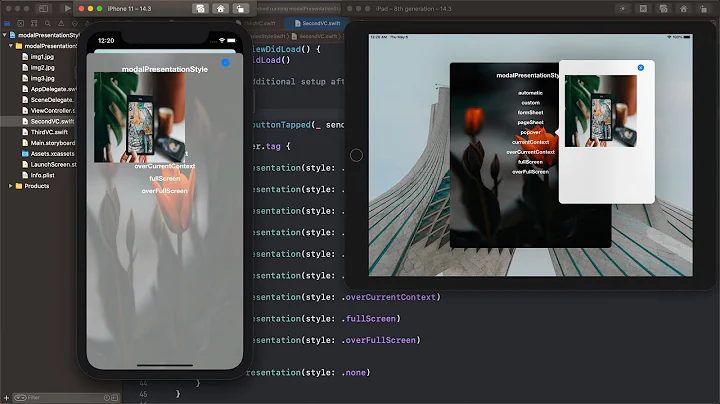UIPopoverPresentationController displaying popover as full screen
Solution 1
In iPhone, you should add the following in order to present a popover.
func adaptivePresentationStyleForPresentationController(controller: UIPresentationController!) -> UIModalPresentationStyle {
// Return no adaptive presentation style, use default presentation behaviour
return .None
}
Solution 2
For Swift3/IOS10, looks like we need to do some thing like
func adaptivePresentationStyle(for controller: UIPresentationController, traitCollection: UITraitCollection) -> UIModalPresentationStyle
{
return .none
}
Adding this answer, in case, someone runs into this problem as i did when migrating to swift3/IOS10
Solution 3
For Swift3+/IOS10+, when dealing with iPhone:
You must add UIPopoverPresentationControllerDelegate the delegate at:
class YourClass: UIViewController, UIPopoverPresentationControllerDelegate { ...
Then implement in this same parent class (which will show the popover) the method below.
func adaptivePresentationStyle(for controller: UIPresentationController, traitCollection: UITraitCollection) -> UIModalPresentationStyle
{
return .none
}
And then set the popover configuration below:
myPopover.modalPresentationStyle = .popover
myPopover.popoverPresentationController?.sourceRect = VIEWTOPOINTTHEARROW.frame
myPopover.popoverPresentationController?.sourceView = self.view
myPopover.popoverPresentationController?.delegate = self
Also you may set some configuration for the popover class
class MyPopover: UIViewController {
override func viewDidLoad() {
super.viewDidLoad()
//popover size
self.preferredContentSize = CGSize(width: 320, height: 200)
//sets the arrow of the popover to same color of background
self.popoverPresentationController?.backgroundColor = self.view.backgroundColor
}
}
Solution 4
The accepted answer is correct. For completeness, see Adapting Presented View Controllers to a New Style in the Apple docs:
Use the delegate’s
adaptivePresentationStyleForPresentationController:method to specify a different presentation style than the default. When transitioning to a compact environment, the only supported styles are the two full-screen styles orUIModalPresentationNone. ReturningUIModalPresentationNonetells the presentation controller to ignore the compact environment and continue using the previous presentation style. In the case of a popover, ignoring the change gives you the same iPad-like popover behavior on all devices.
Make sure that the required configurations from Presenting a View Controller in a Popover are met:
After setting the modal presentation style [of the presented view controller] to
UIModalPresentationPopover, configure the following popover-related attributes:
- Set the
preferredContentSizeproperty of your view controller to the desired size.- Set the popover anchor point using the associated
UIPopoverPresentationControllerobject, which is accessible from the view controller’spopoverPresentationControllerproperty.- Set only one of the following:
- Set the
barButtonItemproperty to a bar button item.- Set the
sourceViewandsourceRectproperties to a specific region in one of your views.
Related videos on Youtube
Comments
-
The Nomad almost 2 years
I am trying to use
UIPopoverPresentationControllerto display apopoverthat doesn't take up the whole screen. I've followed many different tutorials with no luck.Here is my code. It correctly instantiates the
ViewController, but it takes up the entire screen instead of just a smaller screen as I defined inpreferredContentSize.func showPopover() { let vc = self.storyboard?.instantiateViewControllerWithIdentifier("PopupTimePickerViewController") as PopupTimePickerViewController vc.modalPresentationStyle = .Popover vc.preferredContentSize = CGSizeMake(200, 100) if let presentationController = vc.popoverPresentationController { presentationController.delegate = self presentationController.permittedArrowDirections = .Up presentationController.sourceView = self.view presentationController.sourceRect = CGRectMake(0, 0, 50, 50) self.presentViewController(vc, animated: true, completion: nil) } }Update 9/27/16 with correct answer
func adaptivePresentationStyle(for controller: UIPresentationController, traitCollection: UITraitCollection) -> UIModalPresentationStyle { return .none }-
The Nomad over 9 years@gabbler Nope. Only on the simulator. Don't have an iPhone to test it on.
-
 gabbler over 9 yearsPlease try the answer. Don't forget to implement
gabbler over 9 yearsPlease try the answer. Don't forget to implementadaptivePresentationStyleForPresentationControllermethod. -
Alexandre over 6 yearsFor me the problem was that, calling the PopoverViewController through a "PerformSegue" was always leaving it Full Screen. Deleting the storyboard segue and manually assembling it and showing through presentViewController solved it.
-
 MingMan over 5 yearsUpdate saved me. Was stuck for +6 hours
MingMan over 5 yearsUpdate saved me. Was stuck for +6 hours
-
-
 Noah about 8 yearsWhere do you add this? To the view controller of the Popover?
Noah about 8 yearsWhere do you add this? To the view controller of the Popover? -
 gabbler about 8 years@Noah, to the view controller that presents the Popover,
gabbler about 8 years@Noah, to the view controller that presents the Popover,self.presentViewController(vc, animated: true, completion: nil), the controllerselfrepresents. -
Cannoliopsida over 6 yearsOn Swift 4, this won't give an error, but just won't fix the issue. Slight signature tweak:
func adaptivePresentationStyle(for controller: UIPresentationController) -> UIModalPresentationStyle { return UIModalPresentationStyle.none } -
Victor Engel about 5 yearsYes, and in order for it to be called, you need to set the calling view controller as the delegate to the popover's presentationController, as explained in other answers. Then you can look at the protocol definition for the appropriate signature. Xcode should autocomplete with the right one if you've set up the delegate properly.







